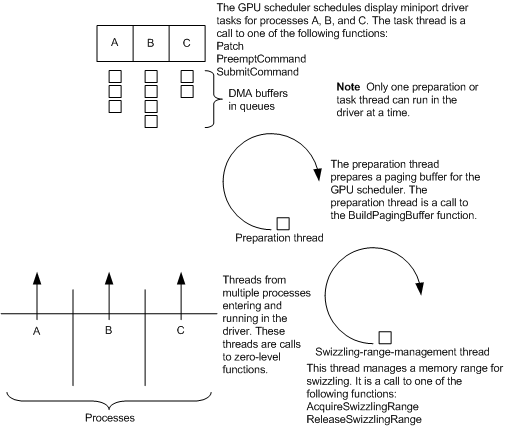Thread Synchronization and TDR
The following figure shows how thread synchronization works for the display miniport driver in the Windows Display Driver Model (WDDM).

If a hardware timeout occurs, the Timeout Detection and Recovery (TDR) process initiates. The GPU scheduler calls the driver's DxgkDdiResetFromTimeout function, which resets the GPU. DxgkDdiResetFromTimeout is called synchronously with any other display miniport driver function, except for the runtime power management functions DxgkDdiSetPowerComponentFState and DxgkDdiPowerRuntimeControlRequest. That is, no other thread runs in the driver while the DxgkDdiResetFromTimeout thread runs. The operating system also guarantees that no access to the frame buffer can occur from any application during the call to DxgkDdiResetFromTimeout; therefore, the driver can reset a memory controller phase locked loop (PLL) and so on.
While the recovery thread executes DxgkDdiResetFromTimeout, interrupts and deferred procedure calls (DPCs) can continue to be called. The KeSynchronizeExecution function can be used to synchronize portions of the reset procedure with device interrupts.
After the driver returns from DxgkDdiResetFromTimeout, most driver functions can again be called, and the operating system starts to clean up resources that are no longer required. During the cleanup period, the following driver functions are called for the indicated reasons:
The driver is called to notify about an allocation being evicted.
For example, if the allocation was paged in a memory segment, the driver's DxgkDdiBuildPagingBuffer function is called with the Operation member of the DXGKARG_BUILDPAGINGBUFFER structure set to DXGK_OPERATION_TRANSFER and with the Transfer.Size member set to zero to inform the driver about the eviction. Note that no content transfer is involved because the content was lost during the reset.
If the allocation was paged in an aperture segment, the driver's DxgkDdiBuildPagingBuffer function is called with the Operation member of DXGKARG_BUILDPAGINGBUFFER set to DXGK_OPERATION_UNMAP_APERTURE_SEGMENT to inform the driver to unmap the allocation from the aperture.
The driver's DxgkDdiReleaseSwizzlingRange function is called to release an unswizzling aperture and segment aperture ranges.
The driver should not access the GPU during the preceding calls unless absolutely necessary.
After the cleanup period is over, the operating system calls the driver's DxgkDdiRestartFromTimeout function to inform the driver that cleanup is complete and that the operating system will resume using the adapter for rendering.
Feedback
Coming soon: Throughout 2024 we will be phasing out GitHub Issues as the feedback mechanism for content and replacing it with a new feedback system. For more information see: https://aka.ms/ContentUserFeedback.
Submit and view feedback for